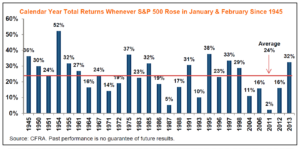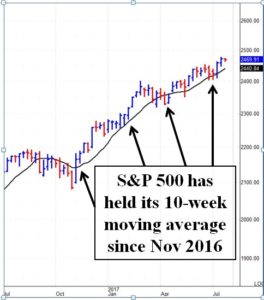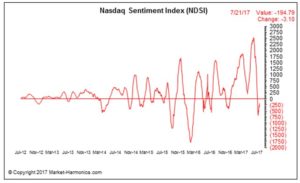We will continue to see more upside into year-end for the following reasons:
1) Strength leads to more strength. Traditionally, when the early parts of the year are strong, the strength continues into year-end. For example, since 1945, January and February have both been positive 27 times (as it was this year). The market finished the rest of those years positive ALL 27 times with an average gain of +24% (see chart below). Also, since 1950, the S&P 500 has been up more than +8% in the first half of the year 25 times (as it was this year). The second half has seen an addition average gain of +7.1% and positive returns 84% of the time (higher 21 out of 25 times). Again, strength usually leads to more strength.
2) Strong technicals. Many people seem to forget that the big institutions control the market and you can follow what they are doing by analyzing the market technicals. For example, the 10-week moving average is traditionally known as an area of institutional support, and the S&P 500 has held this area since after the US Presidential election (see chart below). As long as the market continues to be supported by the large institutions, I will stick with the trend.
3) Fundamentals. The Bears’ biggest argument is that the market is overvalued and they are basing this on historical Price to Earnings (PE) ratios. This thesis is always challenging because there’s not enough data. For example, before 1997, the S&P 500 had an average PE of 13.95. Since 1997, it has averaged 23.36. That’s a HUGE difference! We probably need hundreds of years of data before coming up with any meaningful conclusions about PE. I feel PE ratios are now higher because profit margins are expanding, there are fewer stocks in the market, and there is more money globally that wants to be invested in the US markets. I plan to write a more extensive blog post about this topic in the future.
4) Sentiment. Everyone still hates this market. Let me rephrase. It’s not that people hate this market, they are simply on edge that this rally will end any day now. Even the Bulls I know get scared on every little drop. For example, at the end of June 2017, the Nasdaq dropped over 3% in four weeks and sentiment got DEATHLY bearish to levels even WORSE than pre-US election levels (see chart below). I’m not saying that people have to invest with no fear, but it’s tough to see a significant, sustained drop in the market when everyone is nervous and ready for a correction. Many people seriously underestimate the power of psychology in the market. This constant fear is helping to drive the market higher and it is a generational mentality that will take a long time to change.
5) Resilience. Think of everything that’s been thrown at the market over the past few years: geopolitical concerns, dramatic elections, viruses, Brexit, terrorist attacks, etc. and guess what? The market has been incredibly resilient and literally brushes off any bad news. Now, imagine if we actually get some good news. The media has already thrown in the towel on the Trump administration and many people feel they are incapable of getting anything done. I say HAVE A LITTLE PATIENCE! It takes time to get bills drafted and passed through Congress. If we see anything remotely positive come out of Washington this fall, the market could take off to the upside. This includes health care reform, personal tax reform, repatriation of foreign money, infrastructure plans, corporate tax reform, etc. Progress in any of these areas is NOT priced into the market and could be a significant catalyst.
What would make me change my bullish stance? First and foremost would be if we see consistent selling by the big institutions and if the leading stocks start to breakdown. If this happens, I will simply cut losses because capital preservation is ALWAYS the number one priority for my clients. Also, a sudden rise in interest rates would make me cautious, but I am referring to a spike in the 10-year over 4%. A slow and steady rising rate environment would not be a problem because over the past 15 years, the three biggest moves (2003, 2009, and 2013) have all occurred during rising interest rate periods.
If I am right, here’s the biggest catch: The move higher will not be easy. There will be corrections, shakeouts, and pullbacks along the way. Many of them will be sharp and VERY convincing that the Bull Market is over. For example, even if you guaranteed me the Dow Jones would be over 23,000 by year-end, I will guarantee you we will have at least 10 days similar to 5/17/17, 6/9/17 and 6/27/17. These were all nasty down days that I like to call “days that keep the Bulls in check,” or days to shakeout some of the excess bullishness. In addition, August tends to be the worst month of the year and it wouldn’t surprise me if volatility picks up later this summer. Therefore, it is important to know your time-frame. For traders, the biggest challenge will be the difficult balance of taking some profits into strength and having conviction during the corrections.
The main growth area I will continue to focus on into year-end will be the Semiconductor sector. Chips are no longer just going into computers. They are found in smart phones, cars, watches, memory, sensors, machine learning, artificial intelligence, etc. The “Internet of things” is the inter-networking of all these devices and experts estimate that we will see over 50 billion connected objects by 2020. Nvidia (Symbol: NVDA) is the leader in this sector and continues to be one of the largest positions I hold for clients. The amazing thing is there are about 20 other small and mid-cap stocks that could appreciate 30-100% over the next 6-12 months. Make sure to put in the time, do your homework, and have some conviction in your ideas to maximize this opportunity.
If you are looking for a money manager or would like to set up a FREE consultation, please email me. My skills at finding growth stocks and my 20 years of trading experience will allow me to take advantage of the strength that lies ahead.
I can be reached at: jfahmy@zorcapital.com
Disclaimer: This information is issued solely for informational and educational purposes and does not constitute an offer to sell or a solicitation of an offer to buy securities. None of the information contained in this blog constitutes a recommendation that any particular security, portfolio of securities, transaction, or investment strategy is suitable for any specific person. From time to time, the content creator or its affiliates may hold positions or other interests in securities mentioned in this blog. The stocks presented are not to be considered a recommendation to buy any stock. This material does not take into account your particular investment objectives. Investors should consult their own financial or investment adviser before trading or acting upon any information provided. Past performance is not indicative of future results.




